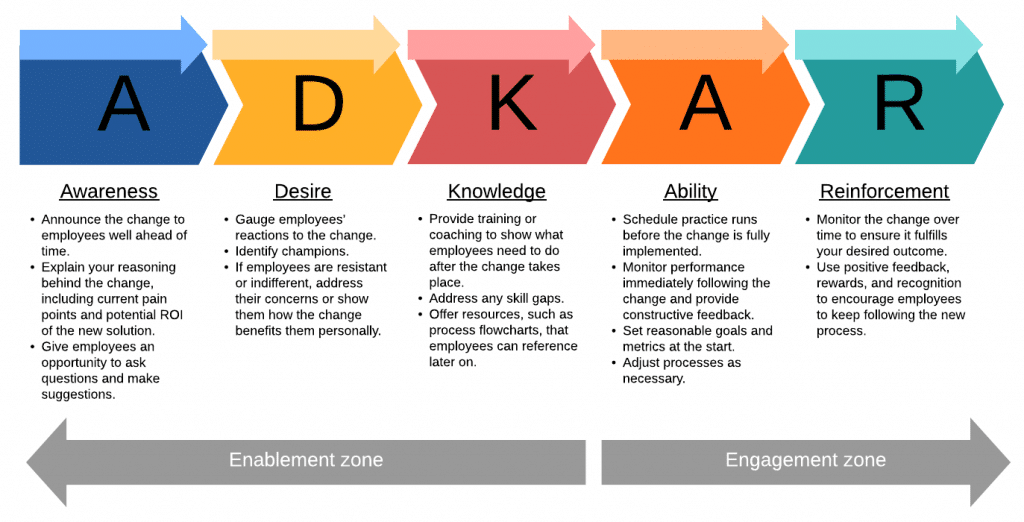The ADKAR Change Management Model was created by Jeffery Hiatt (founder of Prosci) and published in the book ADKAR: A Model for Change in Business, Government and our Community in 2006. The founding idea of this model is to look at the individuals behind the change, thus creating a truly bottom-up approach. It’s not a sequential method (although many illustrations make it appear so), rather a set of goals to reach. Each of these goals makes up a letter of the acronym.
- Awareness of the need for Change.
- Desire to support the Change.
- Knowledge on how to Change.
- Ability to demonstrate skills and behaviours.
- Reinforcement to make the Change stick.
By focusing on achieving each of the five goals, the ADKAR model can be used to effectively plan out change on both an individual and organizational level.
The ADKAR Change Management Model in detail

1. Awareness
The awareness stage is all about making sure that your employees understand the need for change. This is done essentially through communication activities, focused on transparency and on the benefits that we want to achieve.
In this phase, it is important to focus on understanding. It is not just a one-direction communication, but it needs to be a true awareness. Using hard evidence, expressing the ROI of change, as well as being clear about the pains of the process, are all elements that can positively support the process.
The entire model is based on the need to establish Trust as a way to embed change faster and more steadily, which is why this phase is so relevant.
2. Desire
Inspiring the desire to change is the most difficult part of the ADKAR Change Management Model. Here you need to be appealing to both the logical and emotional side of the people involved. Which calls for an important dose of Leadership to be grounded into this step, and ensure you can really deliver commitment.
A key to the success of this phase is to ensure that people understand the benefits of the change and that they feel this can be relevant for them. But a successful Desire goal also means ensuring an effective feedback loop is created with the teams so that concerns are raised immediately and ideas are captured and implemented when relevant
3. Knowledge
The Knowledge goal of the ADKAR Change Management Model is meant to ensure that everyone in the organisation is not only aware but fully understand the need for change and all the steps involved in reaching it.
Best way to achieve this is to have a clear definition of the skills and knowledge needed once the Change is in place, use this to identify all existing gaps, and start a process to fill these gaps through the appropriate training and upskilling activities.
This goes beyond the pure process knowledge though, as the goal requires people to know “how to change”: i.e. it is necessary to accompany the process training with clear guidance on the behavioural and soft-skills needed to proceed through the change process.
4. Ability
The ADKAR Change Management Model, as mentioned, is truly focused on the individuals. Which is why it takes care of carefully distinguishing between the theoretical knowledge of the processes that are changing, and the actual ability to perform the new tasks. A step that is often not considered in depth by other methodologies. And again, it is important to underline that the model accompanies the hard competence with the behavioural component.
As a change leader, you need to plan carefully this phase, both ensuring that practical exercises are added across the entire training phase, but that also a Performance Monitoring approach is put in place early on. Only this way you will be able to understand the real advancement. With the additional benefit of being able to measure the entire Change process.
5. Reinforcement
Reinforcement is the last goal and is about making the Change stick. It means thinking about all the measures (such as appraisals, incentives, rewards) required to ensure that Change becomes the new norm. It also means ensuring you set up a monitoring system early on, both to assess and identify mistakes early on and correct them, but also to evaluate the results of the change process itself.
What’s good about the model
The most positive aspect of ADKAR is that it is a bottom-up approach focused on the individuals and their contribution during the Change program. By focusing on the 5 goals of the Model, you can accelerate the metabolic rate of change in your organisation.
Also, as the model is based on Goals, rather than Steps, it allows to conveniently use the Model in many different situations: from small initiatives to large incremental change projects.
The added focus on the people and their needs rather than just the technical aspects also result in a higher success rate for changes you make.
What’s bad about the model
The model is very well suited for incremental changes, but cannot be used alone for truly transformational initiatives, as it misses the directional aspect of large scale projects.
This means that the ADKAR Change Management Model needs to be complemented by other tools whenever there is a high degree of uncertainty, and directional leadership is required to achieve change.
Conclusion
The ADKAR Change Management Model is great to go to the core of the teams that need to deliver the change. For example, when you are implementing a new system, with processes clearly defined, this model serves well in getting the people committed to the change. Same when there is already a shared understanding of the issues from the beginning and you need to increase the awareness towards the solution.
As long as you already know what you need to change, this model provides a great framework of reference.
For more complex change initiatives, where the level of uncertainty is higher, this model, however, lacks the critical aspects of direction setting and planning. In that case, it can better be used as an integration, for example, to models such as McKinsey or the Nadler-Tushman Congruence model who allow to better define the direction of the Change Initiative.
This post belongs to a series of articles related to Change Management. An introductory article: Change Management: The 10 Best Approaches & Models is available, containing links also to all other posts of the series.

Cover Photo by Nathan Dumlao on Unsplash

[…] Models: the ADKAR Change Management Model […]
[…] Caredda, S. (2020, March 24). Models: the ADKAR Change Management Model. Sergio Caredda. https://sergiocaredda.eu/organisation/tools/models-the-adkar-change-management-model/ […]
[…] Figure 2 – ADKAR Change Management Model(Source: https://sergiocaredda.eu/organisation/tools/models-the-adkar-change-management-model) […]